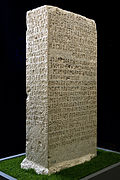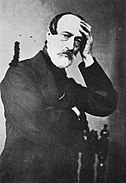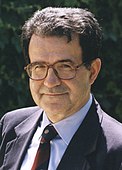History of Italy
| History of Italy |
|---|
 |
|
|
| Part of a series on the |
| Culture of Italy |
|---|
 |
| People |
| Traditions |
The European country of Italy has been inhabited by humans since at least 850,000 years ago. Since classical antiquity, ancient Etruscans, various Italic peoples (such as the Latins, Samnites, and Umbri), Celts, Magna Graecia colonists, and other ancient peoples have inhabited the Italian Peninsula.[1][2]
Italy was the birthplace and centre of the
By the mid-19th century,
Following the end of the German occupation and the killing of Benito Mussolini, the
Prehistory

The arrival of the first
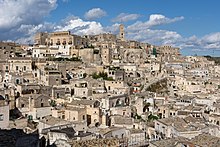
During the Copper Age, Indoeuropean people migrated to Italy in four waves. A first Indoeuropean migration occurred around the mid-3rd millennium BC, from a population who imported
-
Ötzi, a natural mummy dating from the 4th millennium BC
-
ReconstructedTerramarehouses
Nuragic civilization
Born in
No written records of this civilization have been discovered,[30] apart from a few possible short epigraphic documents.[31] The only written information comes from classical literature of the Greeks and Romans, and may be considered more mythological than historical.[32] The language (or languages) spoken in Sardinia during the Bronze Age is (are) unknown since there are no written records from the period, although research suggests that around the 8th century BC the Nuragic populations may have adopted an alphabet similar to that used in Euboea.[33]
-
Bronze sculpture of a Nuragic chief from Uta
Iron Age
Etruscan civilization
The
It is widely accepted that Etruscans spoke a non-
Etruscan expansion was focused across the
Around 540 BC, the
A few years later, in 474 BC, Syracuse's tyrant
-
Necropolis of Banditaccia located in Cerveteri, Lazio
Italic peoples
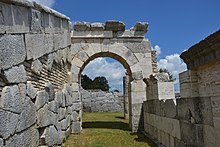

The Italic peoples were an ethnolinguistic group identified by use of Italic languages. Among the Italic peoples in the Italian peninsula were the Osci, the Veneti, the Samnites, the Latins and the Umbri.[39]
In the region south of the Tiber (Latium Vetus), the Latial culture of the Latins emerged, while in the north-east of the peninsula the Este culture of the Veneti appeared. Roughly in the same period, from their core area in central Italy (modern-day Umbria and Sabina), the Osco-Umbrians began to emigrate in various waves, through the process of Ver sacrum, the ritualized extension of colonies, in southern Latium, Molise and the whole southern half of the peninsula, replacing the previous tribes, such as the Opici and the Oenotrians. This corresponds with the emergence of the Terni culture, which had strong similarities with the Celtic cultures of Hallstatt and La Tène.[40]
Before and during the period of the arrival of the Greek and Phoenician immigrants, Sicily was already inhabited by native Italics in three major groups: the Elymians in the west, the Sicani in the centre, and the Sicels (source of the name Sicily) in the east.[41]
It is generally believed that around 2000 BC, the Ligures occupied a large area of the peninsula, including much of north-western Italy and all of northern Tuscany. Since many scholars consider the language of this ancient population to be Pre-Indo-European, they are often not classified as Italics.[42]
By the mid-first millennium BCE, the Latins of
Magna Graecia
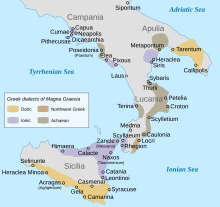
In the eighth and seventh centuries BC, for reasons including demographic crisis, the search for new commercial outlets and ports, and expulsion from their homeland, Greeks began to settle along the coast of Sicily and the southern part of the Italian peninsula, which became known as Magna Graecia.[45]
Many of the new Hellenic cities became very rich and powerful, like Neapolis (
, and others.After
Roman period
Roman Kingdom
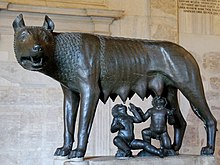
Little is certain about the history of the Roman Kingdom, as nearly no written records from that time survive, and the histories written during the
The traditional account of Roman history, which has come down through Livy, Plutarch, Dionysius of Halicarnassus, and others, is that in Rome's first centuries, it was ruled by a succession of seven kings. The Gauls destroyed much of Rome's historical records when they sacked the city after the Battle of the Allia in 390 or 387 BC. With no contemporary records, all accounts of the kings must be carefully evaluated.[48]
Roman Republic

According to tradition and later writers such as
In the 4th century BC, the Republic came under attack by the
In the 3rd century BC, Rome had to face a new and formidable opponent:

Towards the end of the 2nd century BC, a huge migration of Germanic tribes took place, led by the Cimbri and the Teutones. These tribes overwhelmed the peoples with whom they came into contact and threatened Italy. At the Battle of Aquae Sextiae and the Battle of Vercellae the Germans were virtually annihilated. In these two battles the Teutones and Ambrones are said to have lost 290,000 men, and the Cimbri 220,000.[61]
In the mid-1st century BC, the Republic faced a period of political crisis and social unrest.
Following Antony's Donations of Alexandria, which gave Cleopatra the title of "Queen of Kings", and to their children the regal titles to the newly conquered Eastern territories, war between Octavian and Mark Antony broke out. Octavian annihilated Egyptian forces in the Battle of Actium in 31 BC. Mark Antony and Cleopatra committed suicide. Rome thus possessed unchallenged naval supremacy in the North Sea, Atlantic coasts, Mediterranean, Red Sea, and the Black Sea.
Roman Empire
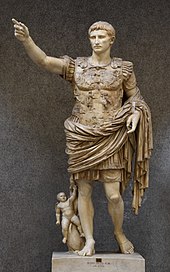
Octavian's leadership brought the
As

Roman literature grew steadily in the
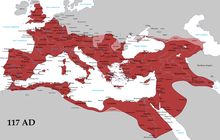
Despite its military strength, the Empire made few efforts to expand, the most notable being the
After the death of Theodosius I (395), the Empire was divided into an Eastern and a Western Roman Empire. The Western part faced increasing economic and political crises and frequent barbarian invasions, so the capital was moved from Mediolanum to Ravenna. In 476, the last Western Emperor Romulus Augustulus was deposed by Odoacer.
Middle Ages
Odoacer's rule ended when the

In 756 Frankish forces defeated the Lombards and gave the Papacy legal authority over much of central Italy, establishing the Papal States. In 800, Charlemagne was crowned emperor of the Holy Roman Empire. After the death of Charlemagne (814), the new empire disintegrated under his weak successors, resulting in a power vacuum in Italy and coinciding with the rise of Islam in North Africa and the Middle East. In the South, there were attacks from the Umayyad Caliphate and the Abbasid Caliphate. In the North, there was a rising power of communes. In 852, the Saracens took Bari and founded an emirate there. Islamic rule over Sicily was effective from 902.
In the 11th century, trade slowly recovered as the cities started to grow again and the Papacy regained its authority. The
Between the 12th and 13th centuries, Italy developed a peculiar political pattern, significantly different from feudal Europe north of the Alps. The oligarchic
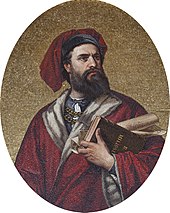
During this period, many Italian cities developed republican forms of government, such as the republics of Florence, Lucca, Genoa, Venice and Siena. During the 13th and 14th centuries these cities became major financial and commercial centres.[89] Milan, Florence and Venice, among other city-states, played a crucial innovative role in financial development, devising the main instruments and practices of banking and new forms of social and economic organization.[87]
During the same period, Italy saw the rise of the
-
The Lombard Kingdom in 740, under King Liutprand
-
Emirate of Sicily (831–1072)
-
Location and coat of arms of the Maritime republics
Renaissance
The recovery from the demographic and economic disaster of the late Middle Ages led to a resurgence of cities, trade and economy. Italy was the main centre of the Renaissance, whose flourishing of the arts, architecture, literature, science, historiography, and political theory influenced all of Europe.
The Italian Renaissance began in Tuscany and spread south, having an especially significant impact on Rome, which was largely rebuilt by the Renaissance popes. The Tuscan variety of Italian came to predominate throughout the region, especially in
The Italian Renaissance was remarkable in economic development. Venice and Genoa were trade pioneers, first as maritime republics and then as regional states, followed by Milan, Florence, and the rest of northern Italy. Reasons for their early development include the relative military safety of Venetian lagoons, the high population density and the institutional structure which inspired entrepreneurs. were invented during this period.
Age of Discovery
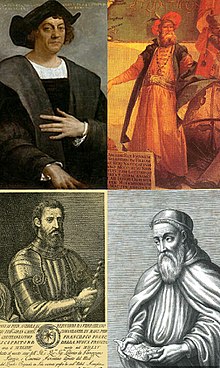
Italian
Warfare
In the 14th century, Northern Italy was divided into warring city-states, the most powerful being
The early Renaissance saw almost constant warfare on land and sea as the city-states vied for preeminence. On land, these wars were primarily fought by armies of mercenaries known as
Foreign invasions of Italy (the
Much of Venice's hinterland (but not the city itself) was devastated by the Turks in 1499 and plundered by the League of Cambrai in 1509. Worst of all was the 6 May 1527 Sack of Rome by mutinous German mercenaries that all but ended the role of the Papacy as the largest patron of Renaissance art. The long Siege of Florence (1529–1530) brought the destruction of its suburbs, the ruin of its export business and the confiscation of its citizens' wealth. Italy's urban population halved; ransoms paid to the invaders and emergency taxes drained the finances. The wool and silk industries of Lombardy collapsed when their looms were wrecked by invaders. The defensive tactic of scorched earth only slightly delayed the invaders, and made the recovery much longer.[106]
From the Counter-Reformation to Napoleon
The 17th century was a tumultuous period in Italian history, marked by deep political and social changes. These included the increase of Papal power in the peninsula and the influence of the Catholic Church at the peak of the
Despite important artistic and scientific achievements, such as the discoveries of
18th century
The
Age of Napoleon

At the end of the 18th century, Italy was almost in the same political conditions as in the 16th century; the main differences were that
Napoleon conquered most of Italy in 1797–99. He set up a series of new republics, complete with new codes of law and abolition of old feudal privileges. Napoleon's
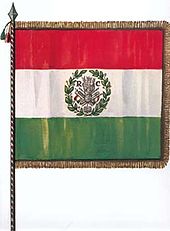
In 1805, after the French victory over the
After Russia, the other states of Europe re-allied themselves and defeated Napoleon at the
On Napoleon's return to France (the
- For nearly two decades the Italians had the excellent codes of law, a fair system of taxation, a better economic situation, and more religious and intellectual toleration than they had known for centuries. ... Everywhere old physical, economic, and intellectual barriers had been thrown down and the Italians had begun to be aware of a common nationality.[126]
Unification (1814–1861)
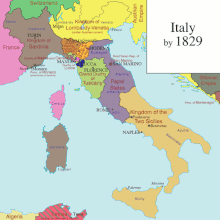
The
In 1820, Spaniards successfully
The leader of the 1821 revolutionary movement in
At the time, the struggle for Italian unification was perceived to be waged primarily against the
Even among those who wanted to see the peninsula unified, different groups could not agree on what form a unified state would take.
One of the most influential revolutionary groups was the
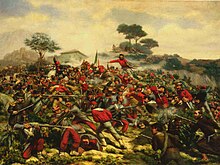
Sardinia industrialized from 1830 onward. A constitution, the Statuto Albertino was enacted in the year of revolutions, 1848, under liberal pressure. Under the same pressure, the First Italian War of Independence was declared on Austria. After initial success, the war took a turn for the worse and the Kingdom of Sardinia lost.
After the
Garibaldi was elected in 1871 in Nice at the National Assembly where he tried to promote the annexation of his hometown to the Italian unitary state, but he was prevented from speaking.[138] Because of this denial, between 1871 and 1872 there were riots in Nice, promoted by the Garibaldini and called "Niçard Vespers",[139] which demanded the annexation of the city and its area to Italy.[140] Fifteen Nice people who participated in the rebellion were tried and sentenced.[141]
Southern question and Italian diaspora
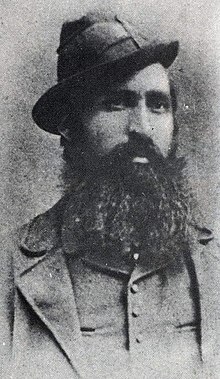
The transition was not smooth for the south (the "
Cavour decided the basic problem was poor government, and believed that could be remedied by strict application of the Piedmontese legal system. The main result was an upsurge in
The first Italian diaspora began around 1880 and ended in the 1920s to the early 1940s with the rise of
Another factor was related to the overpopulation of Southern Italy as a result of the improvements in socioeconomic conditions after Unification.[147] That created a demographic boom and forced the new generations to emigrate en masse in the late 19th century and the early 20th century, mostly to the Americas.[148] The new migration of capital created millions of unskilled jobs around the world and was responsible for the simultaneous mass migration of Italians searching for "work and bread" (Italian: pane e lavoro).[149]
Unification broke down the feudal land system, which had survived in the south since the Middle Ages, especially where land had been the inalienable property of aristocrats, religious bodies or the king. The breakdown of feudalism, however, and redistribution of land did not necessarily lead to small farmers in the south winding up owning arable land. Many remained landless, and plots grew smaller and smaller and so less and less productive, as land was subdivided amongst heirs.[146] Between 1860 and World War I, at least 9 million Italians left permanently of a total of 16 million who emigrated, most travelling to North or South America.[150][148]
Liberal period (1861–1922)
Some of the states that had been targeted for unification (
Parliamentary democracy developed considerably in the 19th century. The Sardinian Statuto Albertino of 1848, extended to the whole Kingdom of Italy in 1861, provided for basic freedoms, but the electoral laws excluded the non-propertied and uneducated classes from voting. Italy's political arena was sharply divided between broad camps of left and right which created frequent deadlock and attempts to preserve governments. Marco Minghetti lost power in 1876 and was replaced by the Democrat Agostino Depretis, who began a period of political dominance in the 1880s, but continued attempts to appease the opposition to hold power.
Depretis began his term by initiating an experimental political idea called Trasformismo (transformism). The theory of Trasformismo was that a cabinet should select a variety of moderates and capable politicians from a non-partisan perspective. In practice, trasformismo was authoritarian and corrupt: Depretis pressured districts to vote for his candidates if they wished to gain favourable concessions from Depretis when in power, resulting in only four representatives from the right being elected in 1876. Depretis put through authoritarian measures, such as banning public meetings, placing "dangerous" individuals in internal exile on remote penal islands, and adopting militarist policies. Depretis enacted controversial legislation for the time, such as abolishing arrest for debt, making elementary education free and compulsory while ending compulsory religious teaching in elementary schools.[154] The first government of Depretis collapsed after his dismissal of his Interior Minister, and ended with his resignation in 1877. The second government of Depretis started in 1881. Depretis' goals included widening suffrage in 1882 and increasing the tax intake from Italians by expanding the minimum requirements of who could pay taxes and the creation of a new electoral system.[155] In 1887, Depretis was finally pushed out of office after years of political decline.
Francesco Crispi was Prime Minister from 1887 until 1891 and again from 1893 until 1896. Historian R.J.B. Bosworth says of his foreign policy that Crispi "pursued policies whose openly aggressive character would not be equaled until the days of the Fascist regime... His policies were ruinous, both for Italy's trade with France, and, more humiliatingly, for colonial ambitions in East Africa."[156] Crispi's major concerns during 1887–91 was protecting Italy from Austria-Hungary. Crispi worked to build Italy as a great world power through increased military expenditures, advocation of expansionism, and trying to win Germany's favor even by joining the Triple Alliance. While helping Italy develop strategically, he continued trasformismo and was authoritarian, once suggesting the use of martial law to ban opposition parties. Despite being authoritarian, Crispi put through liberal policies such as the Public Health Act of 1888 and establishing tribunals for redress against abuses by the government.[157]
The overwhelming attention paid to foreign policy alienated the agricultural community which needed help. Both radical and conservative forces in the Italian parliament demanded that the government investigate how to improve agriculture.[158] The investigation showed that agriculture was not improving, that landowners were swallowing up revenue from their lands and contributing almost nothing to development of the land. There was aggravation by lower class Italians to the break-up of communal lands which benefited only landlords. Most of the workers on the agricultural lands were not peasants but short-term labourers who at best were employed for one year. Peasants without stable income were forced to live off meager food supplies, disease was spreading rapidly, plagues were reported, including a major cholera epidemic which killed at least 55,000 people.[159] The Italian government could not deal with the situation effectively due to the mass overspending that left Italy in huge debt. Italy also suffered economically because of overproduction of grapes in the 1870s and 1880s when France's vineyard industry was suffering from vine disease. Italy during that time prospered as the largest exporter of wine in Europe but following the recovery of France in 1888, southern Italy was overproducing and had to split in two which caused greater unemployment and bankruptcies.[160]
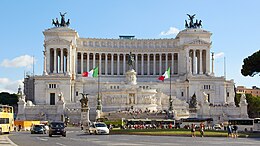
From 1901 to 1914, Italian history and politics was dominated by Giovanni Giolitti. He first confronted the wave of widespread discontent that Crispi's policy had provoked: no more authoritarian repression, but acceptance of protests and therefore of strikes, as long as they are neither violent nor political, with the (successful) aim of bringing the socialists in the political life of the country.[161][162] Giolitti's most important interventions were social and labor legislation, universal male suffrage, the nationalization of the railways and insurance companies, the reduction of state debt, and the development of infrastructure and industry. In foreign policy, there was a movement away from Germany and Austria-Hungary and toward the Triple Entente of France, Britain and Russia.
Starting from the late 19th century, Italy developed its own colonial Empire. It took control of
World War I and failure of the liberal state

Italy entered into the
The war forced the decision whether to honor the alliance with Germany and Austria. For six months Italy remained neutral, as the Triple Alliance was only for defensive purposes. Italy took the initiative in entering the war in spring 1915, despite strong popular and elite sentiment in favor of neutrality. Italy was a large, poor country whose political system was chaotic, its finances were heavily strained, and its army was very poorly prepared.[167] The Triple Alliance meant little either to Italians or Austrians. Prime Minister Antonio Salandra and Foreign Minister Sidney Sonnino negotiated with both sides in secret for the best deal, and got one from the Entente, which was quite willing to promise large slices of the Austro-Hungarian Empire, including the Tyrol and Trieste, as well as making Albania a protectorate. Russia vetoed giving Italy Dalmatia. Britain was willing to pay subsidies and loans to get 36 million Italians as new allies who threatened the southern flank of Austria.[168]

When the Treaty of London was announced in May 1915, there was an uproar from antiwar elements. Reports from around Italy showed the people feared war, and cared little about territorial gains. Pro-war supporters mobbed the streets. The fervor for war represented a bitterly hostile reaction against politics as usual, and the failures, frustrations, and stupidities of the ruling class.[169][170] Benito Mussolini created the newspaper Il Popolo d'Italia, which at first attempted to convince socialists and revolutionaries to support the war.[171] The Allied Powers, eager to draw Italy to the war, helped finance the newspaper.[172] Later, after the war, this publication would become the official newspaper of the Fascist movement.
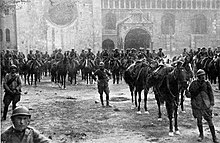
Italy entered the war with an army of 875,000 men, but the army was poorly led and lacked heavy artillery and machine guns, their war supplies having been largely depleted in the war of 1911–12 against Turkey. Italy proved unable to prosecute the war effectively, as fighting raged for three years on a very narrow front along the Isonzo River, where the Austrians held the high ground. In 1916, Italy declared war on Germany. Some 650,000 Italian soldiers died and 950,000 were wounded, while the economy required large-scale Allied funding to survive.[173][174]
Before the war the government had ignored labor issues, but now it had to intervene to mobilize war production. With the main working-class Socialist party reluctant to support the war effort, strikes were frequent and cooperation was minimal, especially in the Socialist strongholds of Piedmont and Lombardy. The government imposed high wage scales, as well as collective bargaining and insurance schemes.[175] Many large firms expanded dramatically. Inflation doubled the cost of living. Industrial wages kept pace but not wages for farm workers. Discontent was high in rural areas since so many men were taken for service, industrial jobs were unavailable, wages grew slowly and inflation was just as bad.[176]
The Italian victory, As the war came to an end,
Furious over the peace settlement, the Italian nationalist poet
The subsequent
Fascist regime, World War II, and Civil War (1922–1946)
Rise of Fascism into power
At the same time, the so-called
Mussolini formed a coalition with nationalists and liberals, and in 1923 passed the electoral
Over the next four years, Mussolini eliminated nearly all checks and balances on his power. On 24 December 1925, he passed a law that declared he was responsible to the king alone, making him the sole person able to determine Parliament's agenda. Local governments were dissolved, and appointed officials (called "Podestà") replaced elected mayors and councils. In 1928, all political parties were banned, and parliamentary elections were replaced by plebiscites in which the Grand Council of Fascism nominated a single list of 400 candidates. Christopher Duggan argues that his regime exploited Mussolini's popular appeal and forged a cult of personality that served as the model that was emulated by dictators of other fascist regimes of the 1930s.[187]
In summary, historian Stanley G. Payne says that Fascism in Italy was:
- A primarily political dictatorship. The Fascist Party itself had become almost completely bureaucratized and subservient to, not dominant over, the state itself. Big business, industry, and finance retained extensive autonomy, particularly in the early years. The armed forces also enjoyed considerable autonomy. ... The Fascist militia was placed under military control. The judicial system was left largely intact and relatively autonomous as well. The police continued to be directed by state officials and were not taken over by party leaders, nor was a major new police elite created. There was never any question of bringing the Church under overall subservience. Sizable sectors of Italian cultural life retained extensive autonomy, and no major state propaganda-and-culture ministry existed. The Mussolini regime was neither especially sanguinary nor particularly repressive.[188]
End of the Roman question
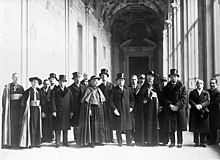
During the
The
Foreign politics
Lee identifies three major themes in Mussolini's foreign policy. The first was a continuation of the foreign-policy objectives of the preceding Liberal regime. Liberal Italy had allied itself with Germany and Austria, and had great ambitions in the Balkans and North Africa. Ever since it had been badly defeated in Ethiopia in 1896, there was a strong demand for seizing that country. Second was a profound disillusionment after the heavy losses of the First World War; the small territorial gains from Austria were not enough to compensate. Third was Mussolini's promise to restore the pride and glory of the Roman Empire.[192]
Italian Fascism is based upon
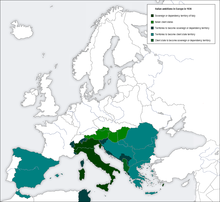
Legend:
Mussolini promised to bring Italy back as a
During the Spanish Civil War between the socialist Republicans and Nationalists led by Francisco Franco, Italy sent arms and over 60,000 troops to aid the Nationalist faction. This secured Italy's naval access to Spanish ports and increased Italian influence in the Mediterranean. During the 1930s, Italy strongly pursued a policy of naval rearmament; by 1940, the Regia Marina was the fourth-largest navy in the world.
Mussolini and Adolf Hitler first met in June 1934, when Mussolini opposed German plans to annex Austria to ensure that Nazi Germany would not become hegemonic in Europe. Public appearances and propaganda constantly portrayed the closeness of Mussolini and Hitler and the similarities between Italian Fascism and German National Socialism. While both ideologies had significant similarities, the two factions were suspicious of each other, and both leaders were in competition for world influence.
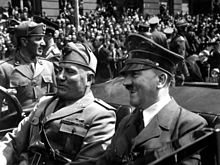
In 1935 Mussolini decided to invade
As war approached in 1939, the Fascist regime stepped up an aggressive press campaign against France claiming that its Italian residents were suffering.
World War II and fall of Fascism
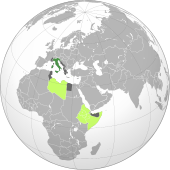
When Germany invaded Poland on 1 September 1939 beginning World War II, Mussolini chose to stay non-belligerent, although he declared his support for Hitler. In drawing out war plans, Mussolini and the Fascist regime decided that Italy would aim to annex large portions of Africa and the Middle East. Hesitance remained from the King and military commander Pietro Badoglio who warned Mussolini that Italy had too few tanks, armoured vehicles, and aircraft available to be able to carry out a long-term war.[204] Mussolini and the Fascist regime thus waited as France was invaded by Germany in June 1940 (Battle of France) before deciding to get involved.
Italy entered the war on 10 June 1940, fulfilling its obligations towards the Pact of Steel. Mussolini hoped to quickly capture
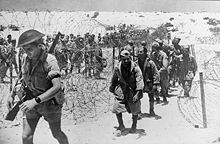
On 28 October, Mussolini launched
By 1943, Italy was losing on every front. Half of the Italian forces
Donald Detwiler notes that "Italy's entrance into the war showed very early that her military strength was only a hollow shell."[208] Historians have long debated why Italy's military and its Fascist regime were so remarkably ineffective at war, which was central to their identity. MacGregor Knox says the explanation, "was first and foremost a failure of Italy's military culture and military institutions."[209] Norman Polmar and Thomas B. Allen argue that "the Regia Aeronautica failed to perform effectively in modern conflict."[210] James Sadkovich gives the most charitable interpretation of Italian failures, blaming inferior equipment, overextension, and inter-service rivalries. Its forces had "more than their share of handicaps."[211]
Civil War, Allied advance, and Liberation
Soon after being ousted, Mussolini was rescued by a German commando in
On 4 June 1944, the German occupation of Rome came to an end as the Allies advanced. The final Allied victory over the Axis in Italy did not come until the spring offensive of 1945, after Allied troops had breached the Gothic Line, leading to the surrender of German and Fascist forces in Italy on 2 May shortly before Germany finally surrendered ending World War II in Europe on 8 May. It is estimated that between September 1943 and April 1945, some 60,000 Allied and 50,000 German soldiers died in Italy.[nb 2]
During World War II,
On 25 April 1945 the
Mussolini was captured on 27 April 1945 and the next day was executed for high treason. On 2 May 1945, the German forces in Italy surrendered. On 9 June 1944, Badoglio was replaced as Prime Minister by anti-fascist leader
Anti-fascism against Mussolini's regime
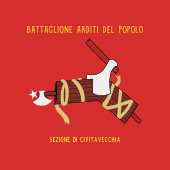
In Italy, Mussolini's
The
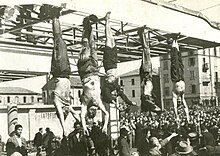
Between 1920 and 1943, several anti-fascist movements were active among the
Republican era (1946–present)
Birth of the Republic
The aftermath of World War II left Italy with a destroyed economy, a divided society, and anger against the monarchy for its endorsement of the Fascist regime. These frustrations contributed to a revival of the Italian republican movement.[241] Umberto II was pressured by the threat of another civil war to call the 1946 Italian institutional referendum to decide whether Italy should remain a monarchy or become a republic. On 2 June 1946, the republican side won 54% of the vote and Italy officially became a republic.
Under the
The
Italy joined the Marshall Plan (ERP) and NATO. By 1950, the economy had largely stabilized and started booming.[243] In 1957, Italy was a founding member of the European Economic Community, which later transformed into the European Union (EU). The Marshall Plan's long-term legacy was to help modernize Italy's economy.[244] By 1953, industrial production had doubled compared with 1938 and the annual rate of productivity increase was 6.4%, twice the British rate.
Economic miracle
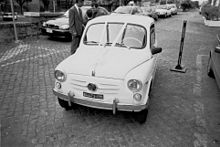
In the 1950s and 1960s, the country enjoyed a prolonged economic boom, which was accompanied by a dramatic rise in the standard of living of ordinary Italians.[245] The so-called Italian economic miracle lasted almost uninterruptedly until the "Hot Autumn's" massive strikes and social unrest of 1969–70, that combined with the later 1973 oil crisis, gradually cooled the economy. It has been calculated that the Italian economy experienced an average rate of growth of GDP of 5.8% per year between 1951 and 1963, and 5.0% per year between 1964 and 1973.[246] Between 1955 and 1971, around 9 million people are estimated to have been involved in inter-regional migrations in Italy, uprooting entire communities.[247] Emigration was especially directed to the factories of the so-called "industrial triangle", a region encompassed between the major manufacturing centres of Milan and Turin and the seaport of Genoa.
The needs of a modernizing economy demanded new transport and energy infrastructures. Thousands of kilometres of railways and highways were completed in record times to connect the main urban areas, while dams and power plants were built all over Italy, often without regard for geological and environmental conditions. Strong urban growth led to uncontrolled urban sprawl. The natural environment was constantly under threat by wild industrial expansion, leading to ecological disasters like the Vajont Dam inundation and the Seveso chemical accident.
Years of Lead

During the 1970s, Italy saw an unexpected escalation of political violence. From 1969 to 1980, repeated neofascist outrages were launched such as the
At the end of the Lead years, the PCI gradually increased their votes thanks to Enrico Berlinguer. The Socialist Party (PSI), led by Bettino Craxi, became more and more critical of the Communists and of the Soviet Union; Craxi himself pushed in favour of US President Ronald Reagan's positioning of Pershing II missiles in Italy.
Second Republic (1992–present)
Italy faced several terror attacks between 1992 and 1993, perpetrated by the
From 1992 to 1997, Italy faced significant challenges as voters disenchanted with political paralysis, massive government debt, extensive corruption, and organised crime's considerable influence collectively called the political system
The
The succeeding centre-left government was headed by
The
On 24 and 25 February 2013, a

The
On 21 July 2022, following a government crisis, Draghi resigned.[274] A snap election resulted in the centre-right coalition gaining an absolute majority.[275] On 22 October 2022, Giorgia Meloni was sworn in as Italy's first female prime minister.[276]
See also
- Duchy of Urbino
- Genetic history of Italy
- History of Capri
- History of Naples
- History of Rome
- History of Sardinia
- History of Sicily
- History of the Republic of Venice
- History of Trentino
- History of Tuscany
- History of Verona
- Kingdom of Lombardy–Venetia
- List of consorts of Montferrat
- List of consorts of Naples
- List of consorts of Savoy
- List of consorts of the Kingdom of the Two Sicilies
- List of consorts of Tuscany
- List of Italian queens
- List of Italian inventions and discoveries
- List of kings of the Lombards
- List of Milanese consorts
- List of Modenese consorts
- List of monarchs of Naples
- List of monarchs of Sardinia
- List of monarchs of Sicily
- List of monarchs of the Kingdom of the Two Sicilies
- List of Parmese consorts
- List of presidents of Italy
- List of prime ministers of Italy
- List of queens of the Lombards
- List of Roman and Byzantine Empresses
- List of rulers of Tuscany
- List of Sardinian consorts
- List of Sicilian consorts
- List of State Archives of Italy
- List of viceroys of Naples
- List of viceroys of Sicily
- Milan
- Military history of Italy
- Politics of Italy
Notes
- the region since antiquity. See Pliny the Elder, Letters9.23.
- ^ In Alexander's Generals Blaxland quotes 59,151 Allied deaths between 3 September 1943 and 2 May 1945 as recorded at AFHQ and gives the breakdown between 20 nationalities: United States 20,442; United Kingdom, 18,737; France, Morocco, Algeria, Tunisia, Senegal and Belgium 5,241; Canada, 4,798; India, Pakistan, Nepal 4,078; Poland 2,028; New Zealand 1,688; Italy (excluding irregulars) 917; South Africa 800; Brazil 275; Greece 115; Jewish volunteers from the British Mandate in Palestine 32. In addition, 35 soldiers were killed by enemy action while serving with pioneer units from Botswana, Lesotho, Swaziland, Seychelles, Mauritius, Sri Lanka, Lebanon, Cyprus and the West Indies[216]
References
- ^ Buti, Gianna G.; Devoto, Giacomo (1974). Preistoria e storia delle regioni d'Italia (in Italian). Sansoni Università.
- ^ Farney, Gary D.; Bradley, Guy (2018). The Peoples of Ancient Italy. de Gruyter.
- ISBN 9780806130040.
Italy homeland of the Romans.
- ISBN 9780199227211.
- ^ Sée, Henri. "Modern Capitalism Its Origin and Evolution" (PDF). University of Rennes. Batoche Books. Archived from the original (PDF) on 7 October 2013. Retrieved 29 August 2013.
The origin and development of capitalism in Italy are illustrated by the economic life of the great city of Florence.
- ^ Sée, Henri. "Modern Capitalism Its Origin and Evolution" (PDF). University of Rennes. Batoche Books. Archived from the original (PDF) on 7 October 2013. Retrieved 29 August 2013.
- ^ Smith, D. Mack (1970). Storia della Sicilia medioevale e moderna (in Italian). Bari: Laterza. pp. 27, 39, 45, 50–51, 98–108, 190–201.
- ISBN 9781426208614.
- ^ Burke, P., The European Renaissance: Centre and Peripheries (1998)
- ISBN 978-0-7735-2836-9. Retrieved 13 June 2016.
The United States is the sole world's superpower. France, Italy, Germany and the United Kingdom are great powers.
- ISBN 978-0-415-66818-7. Retrieved 13 June 2016.
The great powers are super-sovereign states: an exclusive club of the most powerful states economically, militarily, politically and strategically. These states include veto-wielding members of the United Nations Security Council (United States, United Kingdom, France, China, and Russia), as well as economic powerhouses such as Germany, Italy and Japan.
- ^ National Geographic Italia – Erano padani i primi abitanti d'Italia Archived 26 June 2019 at the Wayback Machine(in Italian)
- ^ 42.7–41.5 ka (1σ CI).
Douka, Katerina; et al. (2012). "A new chronostratigraphic framework for the Upper Palaeolithic of Riparo Mochi (Italy)". Journal of Human Evolution. 62 (2): 286–299. PMID 22189428.
- ^ "Sassi di Matera". AmusingPlanet.
- ^ "Età del rame, l'Italia era al centro di una rete di diffusione del metallo" (in Italian). 22 January 2020. Retrieved 22 November 2021.
- ^ "Campaniforme, bicchiere" (in Italian). Retrieved 22 November 2021.
- S2CID 160050623.
- ^ "Terramare culture - ancient culture". Encyclopedia Britannica. Retrieved 13 February 2019.
- ^ One or more of the preceding sentences incorporates text from a publication now in the public domain: Mitchell, John Malcolm (1911). "Terramara". In Chisholm, Hugh (ed.). Encyclopædia Britannica. Vol. 26 (11th ed.). Cambridge University Press. pp. 658–659.
- ^ a b M. Gimbutas Bronze Age Cultures in Central and Eastern Europe pp. 339–345
- ^ John M. Coles The Bronze Age in Europe: An Introduction to the Prehistory of Europe C. 2000–700 BC, pp. 422
- ^ Andrea Cardarelli The collapse of the Terramare culture and growth of new economic and social system during the late Bronze Age in Italy
- ^ Francesco di Gennaro. "Protovillanoviano", Enciclopedia dell'arte antica, Treccani, Rome, 1996
- ISSN 2284-0834. Archived from the originalon 31 July 2021. Retrieved 22 November 2021.
- ^ G. Lilliu (1999) p. 11[full citation needed]
- ISBN 9780195076189.
- ISBN 9789048194131.
- ^ Lilliu, Giovanni (2006). "Sardegna Nuragica" (PDF). Edizioni Maestrali. Archived from the original (PDF) on 3 March 2012.
- ^ There is no complete census, but the figure of 7,000 in E. Contu, "L'architettura nuraghica", in Atzeni et al. (1985), (see Atzeni, E.; et al. (1985). Ichnussa. p. 5.[full citation needed]), is often repeated, and the Provincia di Cagliari website (see "Provincia di Cagliari". Archived from the original on 22 July 2011. Retrieved 22 November 2021.) estimates more than 7,000.
- ^ Monoja, M.; Cossu, C.; Migaleddu, M. (2012). Parole di segni, L'alba della scrittura in Sardegna. Sardegna Archeologica, Guide e Itinerari. Sassari: Carlo Delfino Editore.
- ISBN 978-88-89661-00-0.
- ^ Perra, M. (1993). La Sardegna nelle fonti classiche. Oristano: S'Alvure editrice.
- ^ Ugas, Giovanni (2013). "I segni numerali e di scrittura in Sardegna tra l'Età del Bronzo e il i Ferro". In Mastino, Attilio; Spanu, Pier Giorgio; Zucca, Raimondo (eds.). Tharros Felix. Vol. 5. Roma: Carocci. pp. 295–377.
- ^ PMID 23405165.
- PMID 17357081.
- ISBN 0-292-70687-1.
- ^ ISBN 0-8143-1813-4.
- ^ ISBN 0-8425-2334-0.
- ^ "I popoli italici: l'Italia prima di Roma". www.storicang.it (in Italian). 12 February 2021. Retrieved 19 January 2022.
- ^ Farinacci, Manlio (1997). Carsulae svelata e Terni sotterranea (in Italian). Stampato a cura dell'autore.
- ^ "Chi erano e cosa facevano i siciliani di 3.000 anni fa?". Focus.it. Retrieved 27 January 2022.
- ^ "Liguri". Enciclopedie on line. Treccani.it (in Italian). Rome: Treccani -Istituto dell'Enciclopedia Italiana. 2011.
Le documentazioni sulla lingua dei Liguri non ne permettono una classificazione linguistica certa (preindoeuropeo di tipo mediterraneo? Indoeuropeo di tipo celtico?).
- ^ a b Catherine Mason, Carl Waldman. Encyclopedia of European Peoples. Infobase Publishing. pp. 452–459.
- ISBN 978-0-521-68495-8.
- ^ Emilio Peruzzi, Mycenaeans in early Latium, (Incunabula Graeca 75), Edizioni dell'Ateneo & Bizzarri, Roma, 1980
- ^ "Zottóne duca di Benevento" (in Italian). Retrieved 16 August 2023.
- ^ Adkins, 1998. page 3.
- ^ Asimov, Isaac. Asimov's Chronology of the World. New York: HarperCollins, 1991. p. 69.
- ^ Langley, Andrew and Souza, de Philip, "The Roman Times", Candle Wick Press, Massachusetts
- ^ Matyszak, 2003. pages 43–44.
- ^ Adkins, 1998. pages 41–42.
- ^ Rome: The Roman Republic Archived 14 May 2011 at the Wayback Machine by Richard Hooker. Washington State University. Written 6 June 1999. Retrieved 24 March 2007.
- ^ Haywood, 1971. pages 350–358.
- ^ Pyrrhus of Epirus (2) Archived 14 April 2016 at the Wayback Machine and Pyrrhus of Epirus (3) Archived 3 March 2016 at the Wayback Machine by Jona Lendering. Livius.org. Retrieved 21 March 2007.
- ^ Haywood, 1971. pages 357–358.
- ^ Bagnall 1990
- ^ Rome: The Conquest of the Hellenistic Empires Archived 1 May 2011 at the Wayback Machine by Richard Hooker. Washington State University. Written 6 June 1999. Retrieved 22 March 2007.
- ^ Stevenson (2014). Julius Caesar and the Transformation of the Roman Republic. Routledge.
- ^ Rankin, David (2002). Celts and the Classical World. Routledge. p. 176.
- ^ Between Republic and Empire: Interpretations of Augustus and His Principate. University of California Press. p. 400.
- ^ Livy Ep. 68
- ^ Scullard 1982, chapters VI-VII
- ^ Julius Caesar (100BC – 44BC). [1]. Retrieved 21 March 2007.
- ^ [2] Plutarch, Life of Caesar. Retrieved 1 October 2011
- ^ [3] Plutarch, Parallel Lives, Life of Antony, LXXI, 3–5.
- ^ "LaGrandeBiblioteca.com is available at DomainMarket.com". LaGrandeBiblioteca.com is available at DomainMarket.com. Archived from the original on 2 February 2020. Retrieved 29 January 2020.
- ^ Augustus (63 BC. – AD14) from bbc.co.uk. Retrieved 12 March 2007.
- ^ Langley, Andrew and Souza, de Philip: The Roman Times, pg.14, Candle Wick Press, 1996
- ^ Abbott, 269
- ^ "Quanto era grande l'esercito romano?" (in Italian). Retrieved 16 August 2023.
- ^ Morcillo, Marta García. "The Glory of Italy and Rome's Universal Destiny in Strabo's Geographika, in: A. Fear – P. Liddel (eds), Historiae Mundi. Studies in Universal History. Duckworth: London 2010: 87-101". Historiae Mundi: Studies in Universal History. Retrieved 20 November 2021.
- ISBN 9780709931218. Retrieved 20 November 2021.
- ISBN 9788896543092. Retrieved 20 November 2021.
- ISBN 9780241003909. Retrieved 20 November 2021.
- ISBN 9781472519801. Retrieved 20 November 2021.
- ^ [4] Suetonius, The Twelve Caesars, Augustus, XXI.
- ^ "Pax Romana". Britannica Online Encyclopedia.
- ^ Potter (2009), p. 571.
- ^ Wolfe (2011). From Habiru to Hebrews and Other Essays. p. 65.
- ^ Beck (2012). True Jew: Challenging the Stereotype. p. 18.
- ^ Armstrong (2011). Jerusalem: One City, Three Faiths. p. 163.
- ^ Cristina La Rocca, ed. Italy in the Early Middle Ages: 476-1000 (2002).
- ^ Holger Berwinkel, "Legnano, Battle of (1176)." in Gordon Martel ed The Encyclopedia of War (2011) ch 27.
- ^ Rodney Stark, The Victory of Reason (Random House, 2005).
- ^ Skinner, Quentin, The Foundations of Modern Political Thought, vol I: The Renaissance; vol II: The Age of Reformation, Cambridge University Press, p. 69
- ^ Martin, J. and Romano, D., Venice Reconsidered, Baltimore, Johns Hopkins University, 2000
- ^ a b Ferguson, Niall, The Ascent of Money: The Financial History of the World. Penguin, 2008
- ^ "Marco Polo – Exploration". History.com. Retrieved 9 January 2017.
- ^ de Sismondi, Simonde (1968). Storia delle Repubbliche Italiane nel Medioevo (in Italian). Avanzini e Torraca Editori.
- ^ Armando Lodolini Le repubbliche del mare, Roma, Biblioteca di storia patria, 1967.
- ^ Stéphane Barry and Norbert Gualde, "The Biggest Epidemics of History"-La plus grande épidémie de l'histoire, in L'Histoire n°310, June 2006, pp.45–46
- ^ J. R. Hale, A Concise Encyclopaedia of the Italian Renaissance
- ^ J. H. Plumb, The Italian Renaissance – A Concise Survey of its History and Culture (1985)
- ^ Encyclopædia Britannica, Renaissance, 2008, O.Ed.
- ISBN 0-8108-3724-2
- ISBN 0-679-45088-2
- ISBN 978-0-8078-1925-8.
- ISBN 9781107507180.
- ISBN 9789813108844.
- ^ Encyclopædia Britannica, 1993 ed., Vol. 16, pp. 605ff / Morison, Christopher Columbus, 1955 ed., pp. 14ff
- ^ "Catholic Encyclopedia "John & Sebastian Cabot"". newadvent. 2007. Retrieved 17 May 2008.
- ISBN 9781610699952.
- ^ Greene, George Washington (1837). The Life and Voyages of Verrazzano. Cambridge University: Folsom, Wells, and Thurston. p. 13. Retrieved 18 August 2017 – via Google Books.
- ^ Jensen, De Lamar. Renaissance Europe. 1992, p. 64.
- ^ "Peace of Cateau-Cambrésis". Encyclopædia Britannica. Retrieved 4 December 2014.
- ^ John Julius Norwich, The Italians: History, Art and the Genius of a People (1983) p 165-66.
- S2CID 219359647.
- ^ Carlo M. Cipolla, "The Decline of Italy: The Case of a Fully Matured Economy." Economic History Review 5#2 1952, pp. 178–187. online
- ISBN 9781107507180.
- ISBN 978-0-8018-7308-9.
- ^ "The 17th-century crisis". Encyclopædia Britannica. Retrieved 6 December 2014.
- ISBN 978-1-85109-658-9.
- ^ Fusco, Idamaria. "The plague in the Kingdom of Naples (1656–58): diffusion and mortality" (PDF). Istituto di Studi sulle Società del Mediterraneo. Archived from the original (PDF) on 22 January 2011. Retrieved 6 December 2014.
- History. Archived from the originalon 24 September 2015. Retrieved 6 December 2014.
- ISBN 978-0-19-922720-4.
- ^ Abalain, Hervé, (2007) Le français et les langues historiques de la France, Éditions Jean-Paul Gisserot, p.113
- ^ Alexander Grab, Napoleon and the Transformation of Europe (2003) pp 62–65, 78–79, 88–96, 115–17, 154–59
- ISBN 978-88-04-50946-2.
- ^ The tri-coloured standard.Getting to Know Italy, Ministry of Foreign Affairs (retrieved 5 October 2008) Archived 23 February 2008 at the Wayback Machine
- ^ Article 1 of the law n. 671 of 31 December 1996 ("National celebration of the bicentenary of the first national flag")
- ^ Ferorelli, Nicola (1925). "La vera origine del tricolore italiano". Rassegna Storica del Risorgimento (in Italian). XII (fasc. III): 662. Archived from the original on 31 March 2019. Retrieved 1 October 2021.
- ISBN 88-15-07163-6.
- ^ Dalle grandi rivoluzioni alla Restaurazione. La biblioteca di Repubblica, 2004. pp.342
- ^ Dalle grandi rivoluzioni alla Restaurazione. La biblioteca di Repubblica, 2004. pp.349
- ^ "Proclamation of Rimini". 1815. Archived from the original on 26 January 2008. Retrieved 21 February 2008.
- ^ Frederick B. Artz, Reaction and Revolution: 1814–1832 (1934) pp 142–43
- ^ "Carbonaro – definition of Carbonaro by The Free Dictionary". The free dictionary.com. Retrieved 28 January 2015.
- ^ "Austria Two Sicilies Revolt 1820–1821". Onwar.com. Archived from the original on 11 February 2001. Retrieved 30 September 2014.
- ^ "Scholar and Patriot". Manchester University Press – via Google Books.
- ^ "Giuseppe Garibaldi (Italian revolutionary)". Archived from the original on 26 February 2014. Retrieved 6 March 2014.
- ^ Michael Broers, "Revolution as Vendetta: Patriotism in Piedmont, 1794–1821." Historical Journal 33#3 (1990): 573–597.
- ^ Astarita, Tommaso (2000). Between Salt Water And Holy Water: A History Of Southern Italy. p. 264.
- ^ Hales, E.E.Y. (1954). Pio Nono: A Study in European Politics and Religion in the Nineteenth Century. P.J. Kenedy.
- ISBN 978-88-04-50946-2.
- ^ "Fratelli d'Italia" (in Italian). Retrieved 1 October 2021.
- ^ Smith 1997, p. 15.
- ^ ""Un nizzardo su quattro prese la via dell'esilio" in seguito all'unità d'Italia, dice lo scrittore Casalino Pierluigi" (in Italian). 28 August 2017. Retrieved 14 May 2021.
- ^ "Times article dated February 13, 1871". Retrieved 20 October 2011.
- ^ "I Vespri Nizzardi del 1871: conferenza storica e annullo speciale". Archived from the original on 9 September 2012. Retrieved 20 October 2011.
- ^ J. Woolf Stuart, Il risorgimento italiano, Turin, Einaudi, 1981, p. 44 (In Italian).
- ^ Giuseppe André, Nizza negli ultimi quattro anni, Nice, Editore Gilletta, 1875, pp. 334-335 (In Italian).
- ^ Nelson Moe, The View from Vesuvius: Italian Culture and the Southern Question (2002)
- ^ a b Roland Sarti, Italy: A Reference Guide from the Renaissance to the Present (2004) pp 567–568
- ^ Giuseppe Massari, Stefano Castagnola, Il brigantaggio nelle province napoletane, Fratelli Ferrario, 1863, p.17, 20
- ^ a b Pozzetta, George E., Bruno Ramirez, and Robert F. Harney. The Italian Diaspora: Migration across the Globe. Toronto: Multicultural History Society of Ontario, 1992.
- ^ S2CID 153889304.
- ^ Sori, Ercole. L'emigrazione italiana dall' Unità alla Seconda Guerra Mondiale. First chapter
- ^ a b Gabaccia, Donna (200). Italy's Many Diasporas. New York: Routledge. pp. 58–80.
- ^ Pozzetta, George E. (1980). Pane e Lavoro: The Italian American Working Class. Toronto: Multicultural History Society of Ontorio.
- JSTOR 2137600.
- ^ The Vatican City by the Lateran Treaty of 1929 became an independent country, an enclave surrounded by Italy.
- ISBN 0-674-01870-2.
- ^ "Museo Centrale del Risorgimento di Roma". Istituto per la storia del Risorgimento italiano (in Italian). Retrieved 6 July 2018.
- ^ Smith 1997, pp. 95–107.
- ^ Smith 1997, p. 123.
- ISBN 978-1-134-78088-4.
- ^ Smith 1997, pp. 128–32.
- ^ Smith 1997, pp. 136–38.
- ^ Smith 1997, p. 137.
- ^ Smith 1997, p. 139.
- ^ "Giolitti, Giovanni" (in Italian). Retrieved 23 November 2021.
- ^ J. Alexander, The hunchback's tailor: Giovanni Giolitti and liberal Italy from the challenge of mass politics to the rise of fascism, 1882-1922 (Greenwood, 2001).
- ^ Bosworth 2005, p. 49.
- ^ "Il 1861 e le quattro Guerre per l'Indipendenza (1848-1918)" (in Italian). 6 March 2015. Archived from the original on 19 March 2022. Retrieved 12 March 2021.
- ^ "La Grande Guerra nei manifesti italiani dell'epoca" (in Italian). Archived from the original on 23 September 2015. Retrieved 12 March 2021.
- ISBN 9788856818680. Retrieved 12 March 2021.
- ^ William A. Renzi, In the Shadow of the Sword: Italy's Neutrality and Entrance Into the Great War, 1914–1915 (1987).
- S2CID 162738142.
- ^ Martin Clark, Modern Italy: 1871–1995 (1996) pp 180–85
- ^ Denis Mack Smith, Italy: A Modern History (1969) pp 292–305.
- ISBN 9780520037991. Archivedfrom the original on 21 September 2015. Retrieved 14 August 2015.
- ^ Clark, Martin. 1996. Modern Italy: 1871–1995. (2nd ed. Longman), p. 183.
- ^ Martin Clark, Modern Italy: 1871–1995 (1996) pp 185–94.
- ^ Smith, Italy: A Modern History (1969) pp 307–13.
- ^ Luigi Tomassini, "Industrial Mobilization and the labour market in Italy during the First World War," Social History, (1991), 16#1 pp 59–87
- ^ Tucker, European Powers in the First World War, p 375–76
- ^ Burgwyn, H. James: Italian foreign policy in the interwar period, 1918–1940. Greenwood Publishing Group, 1997. p. 4.
ISBN 0-275-94877-3
- ^ Schindler, John R.: Isonzo: The Forgotten Sacrifice of the Great War. Greenwood Publishing Group, 2001. p. 303.
ISBN 0-275-97204-6
- ISBN 0-394-50694-4
- ^ Giorgio Mortara, La Salute pubblica in Italia durante e dopo la Guerra, G. Laterza & figli, 1925, pp. 28-29, 165.
- ^ Hersch, Liebmann (1927). La mortalité causée par la guerre mondiale (in French). The International Review of Statistics. pp. 52–59.
- ^ Smith (1997), p. 293.
- ^ G.Sabbatucci, La vittoria mutilata, in AA.VV., Miti e storia dell'Italia unita, Il Mulino, Bologna 1999, pp.101-106
- ^ Passmore Women, Gender and Fascism, pp. 11–16.
- ^ Smith (1997), pp. 284–286.
- ^ Smith (1997), pp. 284.
- ^ Christopher Duggan, Fascist Voices: An Intimate History of Mussolini's Italy (2012) excerpt
- ISBN 978-0-299-14873-7.
- ^ "Vatican City turns 91". Vatican News. 11 February 2020. Retrieved 2 September 2021.
The world's smallest sovereign state was born on February 11, 1929, with the signing of the Lateran Treaty between the Holy See and the Kingdom of Italy
- ^ A History of Western Society (Tenth ed.). Bedford/St. Martin's. 2010. p. 900.
- ^ Constitution of Italy, article 7.
- ISBN 978-0-415-45484-1.
- ^ Aristotle A. Kallis. Fascist ideology: territory and expansionism in Italy and Germany, 1922–1945. London, England, UK; New York City, US: Routledge, 2000, pp. 41.
- ^ Terence Ball, Richard Bellamy. The Cambridge History of Twentieth-Century Political Thought. Pp. 133
- ^ Jozo Tomasevich. War and Revolution in Yugoslavia 1941–1945: Occupation and Collaboration. Stanford, California, US: Stanford University Press, 2001. P. 131.
- ^ Aristotle A. Kallis. Fascist Ideology: Expansionism in Italy and Germany 1922–1945. London, England; UK; New York, New York, US: Routledge, 2000. P. 118.
- ^ Mussolini Unleashed, 1939–1941: Politics and Strategy in Fascist Italy's Last War. Cambridge, England, UK: Cambridge University Press, 1986, 1999. P. 38.
- ISBN 9783643901293.
- ^ Smith. 1983. p172
- ^ Clodfelter 2017: 355
- ^ Gilbert, Martin (introduction). 1939. The Illustrated London News: Marching to War, 1933–1939. Toronto, Canada: Doubleday Canada Ltd. Pp 137
- ^ Smith 1997, p. 397.
- ^ a b Smith 1997, p. 401.
- ^ Smith 1997, p. 405.
- ^ Smith 1997, p. 406.
- ^ Smith 1997, p. 412.
- ^ Smith 1997, pp. 412–413.
- ISBN 978-0-8240-4313-1.
- ISBN 978-1-139-43203-0.
- ISBN 978-0-486-47962-0.
- ^ James J. Sadkovich, "Understanding Defeat: Reappraising Italy's Role in World War II," Journal of Contemporary History (1989) 24#1 pp. 27–61 online.
- ^ G. Bianchi, La Resistenza, in: AA.VV., Storia d'Italia, vol. 8, pp. 368-369.
- ISBN 88-339-0629-9.
- ^ a b "Oct. 13, 1943 | Italy Switches Sides in World War II". The New York Times. 13 October 2011. Retrieved 29 August 2021.
- ^ "Italy declares war on Germany". History.com. Retrieved 30 August 2021.
- ^ Blaxland (1979), p. 11
- ^ James H. Burgwyn (2004). General Roatta's war against the partisans in Yugoslavia: 1942 Archived 21 September 2013 at the Wayback Machine, Journal of Modern Italian Studies, Volume 9, Number 3, pp. 314–329(16)
- ^ Italy's bloody secret (archived by WebCite), written by Rory Carroll, Education, The Guardian, June 2001
- JSTOR 4141408?Britain and the 'Hand-over' of Italian War Criminals to Yugoslavia, 1945–48. Journal of Contemporary History. Vol. 39, No. 4, Special Issue: Collective Memory, pp. 503–529
- ISBN 88-04-55129-1
- ISBN 978-88-8325-135-1
- ^ There are three fundamental decrees that seal the legislative work, already active since 1944: All powers to CLNAI; Decree for the administration of justice; Of socialization.
- ^ "Fondazione ISEC - cronologia dell'insurrezione a Milano - 25 aprile" (in Italian). Retrieved 14 February 2022.
- ^ "DECRETO LEGISLATIVO LUOGOTENENZIALE 22 aprile 1946, n. 185" (in Italian). Retrieved 28 April 2015.
- ^ Charles F. Delzell, edit., Mediterranean Fascism 1919-1945, New York, NY, Walker and Company, 1971, p. 26
- ^ "Working Class Defence Organization, Anti-Fascist Resistance and the Arditi Del Popolo in Turin, 1919-22" (PDF). Archived (PDF) from the original on 19 March 2022. Retrieved 23 September 2021.
- ^ Working Class Defence Organization, Anti-Fascist Resistance and the Arditi Del Popolo in Turin, 1919-22 Archived 19 March 2022 at the Wayback Machine, Antonio Sonnessa, in the European History Quarterly, Vol. 33, No. 2, 183-218 (2003)
- ^ "Anarchist Century". Anarchist_century.tripod.com. Retrieved 7 April 2014.
- ^ Bruscino, Felicia (25 November 2017). "Il Popolo del 1925 col manifesto antifascista: ritrovata l'unica copia". Ultima Voce (in Italian). Retrieved 23 March 2022.
- ^ James Martin, 'Piero Gobetti's Agonistic Liberalism', History of European Ideas, 32, (2006), pp. 205–222.
- ISBN 978-0-7425-3123-9. Retrieved 11 June 2020.
- ISBN 978-1-349-95028-7.
- ISBN 978-0-19-536396-8. Retrieved 11 June 2020.
- ^ James D. Wilkinson (1981). The Intellectual Resistance Movement in Europe. Harvard University Press. p. 224.
- ^ Milica Kacin Wohinz, Jože Pirjevec, Storia degli sloveni in Italia: 1866–1998 (Venice: Marsilio, 1998)
- ^ Milica Kacin Wohinz, Narodnoobrambno gibanje primorskih Slovencev: 1921–1928 (Trieste: Založništvo tržaškega tiska, 1977)
- ^ Milica Kacin Wohinz, Prvi antifašizem v Evropi (Koper: Lipa, 1990)
- ^ Mira Cenčič, TIGR: Slovenci pod Italijo in TIGR na okopih v boju za narodni obstoj (Ljubljana: Mladinska knjiga, 1997)
- ^ Vid Vremec, Pinko Tomažič in drugi tržaški proces 1941 (Trieste: Založništvo tržaškega tiska, 1989)
- ^ "Intelligence and Operational Support for the Anti-Nazi Resistance". Darbysrangers.tripod.com.
- ^ "Italia", Dizionario enciclopedico italiano (in Italian), vol. VI, Treccani, 1970, p. 456
- ^ Tobagi, Benedetta. "La Repubblica italiana | Treccani, il portale del sapere". Treccani.it. Retrieved 28 January 2015.
- ^ Christopher Duggan, Force of Destiny: A History of Italy Since 1796 (2008) ch 27
- S2CID 153463824.
- ^ Modern Italy 1871–1995 by Martin Clark
- ISBN 0-521-49627-6.
- ISBN 1-4039-6153-0.
- ^ Alessandra Diazzi and Alvise Sforza Tarabochia, The Years of Alienation in Italy: Factory and Asylum Between the Economic Miracle and the Years of Lead (2019), pp 1-40.
- ^ Richard Drake, "Italy in the 1960s: A Legacy of Terrorism and Liberation." South Central Review 16 (1999): 62-76. online
- ^ "New Arrests for Via D'Amelio Bomb Attack". corriere.it. 8 March 2012.
- ^ "Sentenza del processo di 1º grado a Francesco Tagliavia per le stragi del 1993" (PDF).
- ^ "Audizione del procuratore Sergio Lari dinanzi alla Commissione Parlamentare Antimafia – XVI LEGISLATURA (PDF)" (PDF).
- ^ Sarah Waters, "'Tangentopoli' and the emergence of a new political order in Italy." West European Politics (1994): 17#1 pp:169–182.
- ^ Donald Sassoon, "Tangentopoli or the democratization of corruption: Considerations on the end of Italy's first republic." Journal of Modern Italian Studies (1995) 1#1 pp: 124–143.
- OECD. Retrieved 8 February 2015.
- ^ Moody, Barry; Mackenzie, James (8 November 2011). "Berlusconi to resign after parliamentary setback". Reuters. Archived from the original on 18 September 2012. Retrieved 8 February 2015.
- ^ Krugman, Paul (24 February 2013). "Austerity, Italian-Style". The New York Times. Retrieved 26 November 2017.
- ^ Orsi, Roberto (8 October 2013). "The Demise of Italy and the Rise of Chaos". London School of Economics. Retrieved 26 November 2017.
- ^ "Italy Prime Minister Mattro Renzi on Senate Reform". Bloomberg. 29 September 2015. Retrieved 29 September 2015.
- ^ "Fear of migrants feeds growth of Italy's far-right". The Irish Times. 17 February 2018. Retrieved 10 June 2021.
- ^ "Opinion – The Populists Take Rome". The New York Times. 24 May 2018. Retrieved 2 June 2018 – via NYTimes.com.
- ^ "Italy's Conte forms coalition of bitter rivals, booting far-right from power". France 24. 5 September 2019. Retrieved 9 September 2019.
- ^ "New Italian government formed, allying M5S and the centre-left | DW | 4 September 2019". Deutsche Welle. 4 September 2019. Retrieved 9 September 2019.
- ^ Nuovo coronavirus, Minsitero della Salute
- ^ "Italy extends emergency measures nationwide". BBC News. 10 March 2020.
- ISSN 0261-3077. Retrieved 12 March 2020.
- ^ De Feo, Gianluca (20 March 2020). "Sondaggio Demos: gradimento per Conte alle stelle". YouTrend (in Italian). Retrieved 22 March 2020.
- ^ "Blog | Coronavirus, la sospensione delle libertà costituzionali è realtà. Ma per me ce la stiamo cavando bene". Il Fatto Quotidiano (in Italian). 18 March 2020. Retrieved 22 March 2020.
- ^ "Un uomo solo è al comando dell'Italia, e nessuno ha niente da ridire". Linkiesta (in Italian). 24 March 2020. Retrieved 4 March 2020.
- Raidió Teilifís Éireann. 18 March 2021. Retrieved 10 June 2021.
- ^ L'Italia pagherà il conto più salato della crisi post-epidemia, AGI
- ^ "Mario Draghi sworn in as Italy's new prime minister". BBC News. 13 February 2021.
- ^ "Sergio Mattarella: At 80, Italy president re-elected on amid successor row". BBC News. 29 January 2022.
- ^ "Italy heads to early election after Draghi's coalition fails". Associated Press. 21 July 2022.
- ^ "Italy's far-right Meloni begins tricky government talks". France 24. Agence France-Press. 27 September 2022. Retrieved 2 October 2022.
- ^ "Who is Giorgia Meloni? The rise to power of Italy's new far-right PM". BBC News. 21 October 2022.
Sources
- Bosworth, Richard J. B. (2005). Mussolini's Italy.
- ISBN 978-1408827246.
- ISBN 978-1846142512.
- Smith, Denis Mack (1983). Mussolini: A Biography. Vintage Books. ISBN 978-0394716589.
- Smith, Denis Mack (1997). Modern Italy: A Political History. The University of Michigan Press. ISBN 0-472-10895-6.








